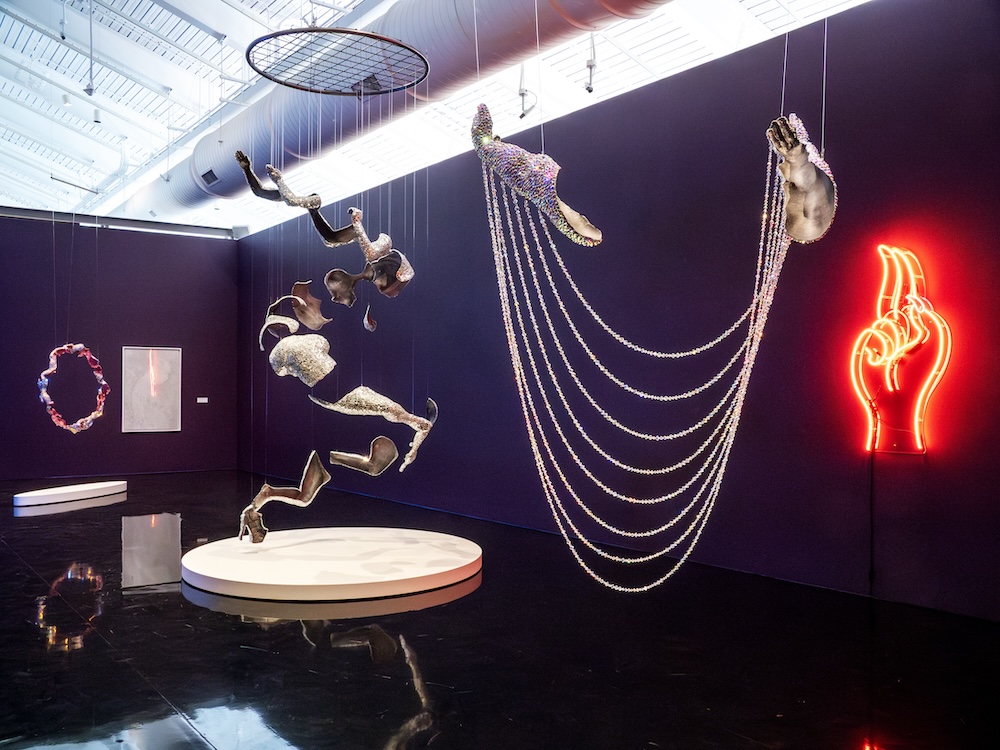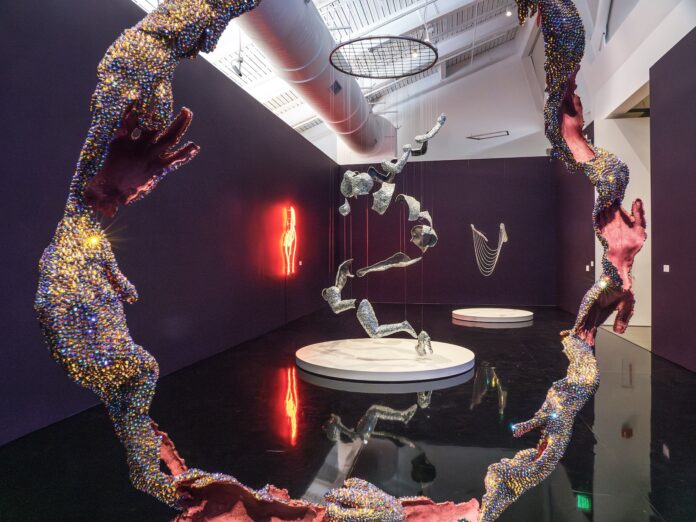It’s odd to look at a project and think of it not as bad, but have the unshakable sensation that something’s missing. Not that the latest commission for BAMPFA’s ongoing MATRIX program is incomplete. Sure, there are missing pieces of sculptures, but that’s by design. No, what feels incomplete is that it feels like a sampler platter rather than a full meal.
The proverbial platter is MATRIX 285 / Young Joon Kwak: Resistance Pleasure (through December 15 at the Berkeley Art Museum & Pacific Film Archive), a small collection of work from the Korean American artist/musician/performer. As we learn during an opening night chat with curator Anthony Graham, the LA-based Kwak’s talent encompass drag, music (with their band, Xina Xurner), film, video, and more. All of it “representing [their] body as continually transforming.”
A description of their piece “Divine 뽀뽀 (twilight)” (2023) in a slideshow hosted by Kwak themself immediately catches the eye. It features the resin likeness of two Korean women (their ethnicity and gender are impossible to tell on sight) kissing. The exterior of the piece is covered in rhinestones (a frequent Kwak motif), with its interior featuring a detailed mold of both faces. Kwak tells us that queer identity isn’t as accepted in South Korea as it is in the West, so this piece—which they admit was influenced by Dave Wojnarowicz’s infamous 1984 work (but not René Magritte’s “The Lovers”)—was nothing less than an act of rebellion by its two otherwise-anonymous models.
That piece is not featured in the MATRIX exhibit, nor is a similar piece, “To Refuse Looking Away from Our Transitioning Bodies (Pregnant Kim)” (2023), which is molded around a pregnant trans-femme bod. Similar works are. One such piece is “Circle Dance of Divine Queer Futures” (with Charlie Roses, 2022), a pink-resin-and-rhinestone-studded ring of hands that resembles a crown of thorns from a distance. It appears to suggest a necessary unity between queer elders and the generations who succeed them. Another is the newly-made “Divine Dance of Soft Revolt (Anna, Travis, Me)” (with Charlie Roses, Brianna Aguilera, Ian Smith, and Jacky Perez; 2024), where separate parts—a high-heeled pump, arms, torsos, et. al—ascend from the platform to the roof of the gallery in a swirl that suggests a cyclone, or perhaps a DNA helix. The non-studded interior reveals that the model(s?) wore leather gear when placed in the molds for the piece.

The third resin piece is “Veil” (with Charlie Roses, Brianna Aguilera, Ian Smith, and Jacky Perez; 2024), featuring the spike-studded molds of two arms stretched out like those of a child reaching for a parent. The arms are joined by eight ropes of Swarovski crystals that, as they hang, slightly resemble a Middle Eastern-style chain veil.
“Veil” hangs across from a curious outlier in the collection: the graphite-on-paper portrait “Phantom Bear” (with Charlie Roses, 2022), showing the portly silhouette that one assumes to be, well, a bear. In fact, the smudges used to depict the silhouette almost resemble shaved hair strands.
Rounding out the collection are two newly-made neon light works. The first is “Erect Limp” (with Dani Bonnet, 2024), which isn’t what you think: it’s a neon animation of a blue hand with red nail polish; at one point, upright (as if to receive a high-five) and then, effeminately flaccid at the wrist. The other is the titular “Resistance Pleasure” (also with Dani Bonnet, 2024), featuring a pink clenched fist that animates to extend the middle finger.

None of these works are bad. In fact, the opening night talk effectively illustrated how these pieces fit into Kwak’s overall oeuvre. The problem is that after seeing that opening night slideshow, it seems a bit too small a sample of Kwak’s work. Just a cursory glimpse over their website shows such a wide range of pieces and mediums that the gallery collection comes off as too limited. Perhaps if Graham had included videos of Kwak’s music and drag along with one or two more art pieces from other mediums, it would better showcase the range of the eclectic artist. Instead, one imagines seeing the current collection in BAMPFA and only stopping in the gallery for glance rather than a linger. (Then again, the point of museums and galleries is to move at your own pace, so maybe everyone will take their due time.)
The hour-or-so slideshow and talk took place in BAMPFA’s Barbro Osher Theater. It wasn’t full, but I’d say I was one of maybe five people masked. During that hour, my Aranet4’s CO² readings peaked 597ppm. The gallery viewing was standing-room-only, but even then, readings only hovered around 547ppm. It helps that BAMPFA is blessed with high ceilings and wide rooms, along with a pretty good HVAC system.
Having now learned the name “Young Joon Kwak,” I look forward to encountering their work again. It definitely speaks to the intent of the artist who sees the queer (particularly trans) body as a bold statement unto itself. A shame that in this show, that statement isn’t as clearly represented. It would be great if it leads others to find the artist’s work, but they may feel a bit short-changed by what they initially got.
Then again, a seasoned performer like Kwak probably knows the benefit of a great tease.
MATRIX 285 / YOUNG JOON KWAK: RESISTANCE PLEASURE runs through December 15. Berkeley Art Museum & Pacific Film Archive. Tickets and more info here.




